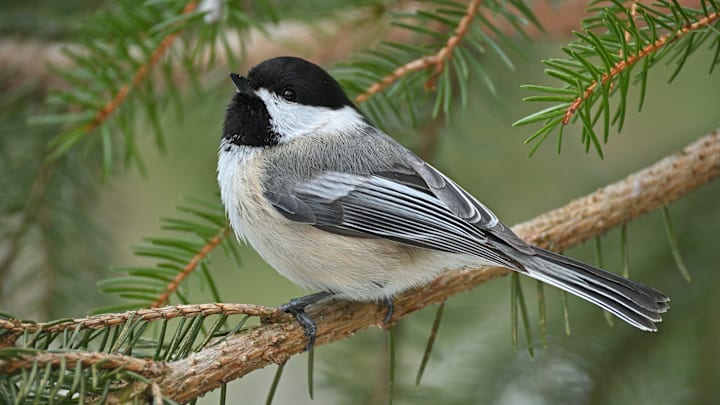Even the most casual backyard birder in North America is familiar with chickadees. These charismatic, noisy little birds visit our feeders and enliven our hedges. But chickadees are more than just cute—they’re hardy survivors that have conquered the continent and are teaching scientists new things about bird communication and evolution. Here are 10 facts to help you get to know these fascinating birds.
- There isn’t just one “chickadee.”
- A group of chickadees is called a “banditry.”
- Chickadees nest in cavities, but they don’t always excavate them themselves.
- Chickadees are experts at winter survival.
- They have amazing spatial memory.
- Their diet changes with the seasons.
- Chickadees’ “chick-a-dee-dee-dee” call is a code for warning about predators.
- The smallest is the tiny chestnut-backed chickadee of the West Coast.
- One chickadee species spans two continents—and has two names.
- Scientists are studying chickadees to learn more about evolution and how new species arise.
There isn’t just one “chickadee.”

Seven different chickadee species live across all of North America. In most of the U.S., the familiar backyard chickadee is either the Carolina chickadee (in the Southeast) or the black-capped chickadee (to the north and west). But these are just two of the seven species that share the name chickadee, from the Mexican chickadee of Mexico’s montane forests to the boreal chickadee that haunts the swamps at the edge of the Arctic. Eight more members of the same genus, Poecile, live in Eurasia, but there they go by the name tit.
A group of chickadees is called a “banditry.”

The name presumably comes from their super-recognizable markings: white cheeks, a black chin, and a black cap (or gray or brown in some species) that extends down past their eyes, forming a “bandit mask.” One species, the mountain chickadee, completes this look with a rakish white eyebrow.
Chickadees nest in cavities, but they don’t always excavate them themselves.

Chickadees can dig out their own nest holes, but if they can find themselves an old woodpecker hole to move into, so much the better. They line these cavities with animal fur and soft plant material to insulate them and make them comfortable. Most chickadees will happily nest in birdhouses provided by humans, as well.
Chickadees are experts at winter survival.

Chickadees don’t migrate—they stay in more or less the same area year-round. That means they have to make it through the coldest, harshest parts of the year. In winter, chickadees spend almost every moment seeking and eating food to keep their metabolisms going. At night, they shelter in cavities similar to the ones they use for nesting in spring, and they can even enter a state of controlled hypothermia to conserve energy.
They have amazing spatial memory.
Chickadees prepare for winter by hiding, or “caching,” seeds to retrieve and eat later. To manage this, they have excellent spatial memory—and the harsher the winters where a chickadee lives, the better its spatial memory is. Some research suggests that black-capped chickadees even grow new neurons in their hippocampi (the brain region that deals with memory) each fall to keep track of all of their hiding places.
Their diet changes with the seasons.
In winter, about half of a chickadee’s diet is made up of easily-stored seeds. But in spring and summer, when protein-rich insects are abundant, they switch over to eating almost entirely insects and other invertebrates. This high-protein diet is also key for the healthy development of baby birds in spring.
Chickadees’ “chick-a-dee-dee-dee” call is a code for warning about predators.
Chickadees get their name from their alarm call, which sounds like “chick-a-dee-dee.” (Their song varies from species to species, but typically it sounds more like “fee-bee, fee-bee.”) This “chick-a-dee” call is a warning to other birds in the area about a predator or other threat—but there’s an additional message included. Ornithologists have found that the more dees a chickadee tacks onto the end, the bigger the perceived threat. Usually it’s three or four, but when researchers showed captive chickadees a pygmy owl, they let loose with an impressive 23 dees.
The smallest is the tiny chestnut-backed chickadee of the West Coast.

Small and short-tailed, with high, squeaky calls, chestnut-backed chickadees get their name from the patch of reddish feathers across their backs. Their preferred habitat is the dense, moist forests of the West Coast, they sometimes wander inland, where they can overlap with their cousins the black-capped chickadee and mountain chickadee. In recent decades, they’ve been expanding their range and moving into the suburbs of San Francisco.
One chickadee species spans two continents—and has two names.

The rare and mysterious gray-headed chickadee lives in remote areas of Alaska, where it haunts the edges of spruce forests. But its range spans the Bering Strait, and it’s also found throughout much of northern Eurasia, where birdwatchers know it as the Siberian tit. It may be the chickadee (or tit!) species most at risk from human disturbance in its habitat.
Scientists are studying chickadees to learn more about evolution and how new species arise.
Some chickadee species are so closely related to each other that they can hybridize, or mate with each other, and even produce fertile offspring. Scientists are studying the characteristics and genomes of these hybrids and their parents, hoping to learn more about how new species evolve, thrive, and remain separate from other, related bird lineages.
Discover More Amazing Bird Facts:
